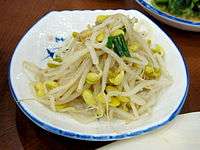Soybean sprout
| Soybean sprout | |||||||||
.jpg) | |||||||||
| Korean name | |||||||||
|---|---|---|---|---|---|---|---|---|---|
| Hangul | 콩나물 | ||||||||
| Literal meaning | bean namul | ||||||||
| |||||||||
| Chinese name | |||||||||
| Traditional Chinese | 黃豆芽 | ||||||||
| Simplified Chinese | 黄豆芽 | ||||||||
| Literal meaning | yellow bean sprout | ||||||||
| |||||||||
| Japanese name | |||||||||
| Kanji | 豆萌やし | ||||||||
| Kana | まめもやし | ||||||||
| |||||||||
| Indonesian name | |||||||||
| Indonesian | kecambah kacang kedelai | ||||||||
| Malay name | |||||||||
| Malay | tauge kasar | ||||||||
| Vietnamese name | |||||||||
| Vietnamese | giá đậu nành | ||||||||
Soybean sprout, also known as kongnamul, is a culinary vegetable grown by sprouting yellow and round soybeans. It can be grown by placing and watering the sprouted soybeans in the shade until the roots grow long. Soybean sprouts are extensively cultivated and consumed in Korea.
History
It is assumed that soybean sprouts has been eaten since the Three Kingdoms of Korea.[1] Records of kongnamul cultivation are found in a Goryeo medical book, Hyangyak gugeupbang. In 935, during the founding of Goryeo, a Taebong general Bae Hyeongyeong(배현경) fed starving soldiers on the sprouts of soybean.[1]
Cooking methods of kongnamul are listed in Sallim gyeongje, a Joseon farming and living book. Another Joseon document Seongho saseol states that the poor used kongnamul to make juk(rice porridge). According to Cheongjanggwan Jeonseo, an essay collection from Joseon era, kongnamul was one of the main food consumed during famine.
Culinary use
Korea
In Korea, the word kongnamul refers to both the soybean sprouts themselves and the namul(vegetable side dishes) made from soybean sprouts. Kongnamul is one of the most common and basic ingredient in Korean cuisine. It is used in bibimbap and varieties of jjim dishes, such as agujjim(angler jjim).
Dishes
- kongbul(or kongnamul bulgogi) – a type of spicy pork bulgogi, made by cooking together a large amount of soybean sprouts, very thin slices of pork belly, sliced onion, scallion, red and green chilli, kkaennip(perilla leaves), and the sauce made of gochujang(chilli paste), gochutgaru(chilli powder), minced garlic, seasoned rice wine, soy sauce, and sugar
- kongnamul – a type of namul, made by stir-frying soybean sprouts in a very small amount of sesame oil, then adding some water and salt to it, simmering until the water is reduced. It is served with toasted sesame seeds sprinkled on top. It is a common dish for jesa(ancestral rite).
- kongnamulbap – bap(rice) cooked together with soybean sprouts, and usually eaten with seasoned sauce made of soy sauce, finely chopped scallions, finely chopped red and green chilli, minced garlic, toasted sesame seeds, and sesame oil.
- kongnamulguk – a type of guk(soup), made by boiling soybean sprouts in anchovy-kelp broth, then season with minced garlic, salt(or saeujeot), and chopped scallions. Gochutgaru(chilli flakes) can also be added.
- kongnamulgukbap – also called kongnamul haejangguk(soybean sprout hangover soup). It is a combination of kongnamulguk(soybean sprout soup) and bap(cooked rice), usually served in a ttukbaegi(earthenware pot), with the rice in the bottom and the soup poured over the top. The soup is made by boiling soybean sprouts in broth of bugeo(dried pollock)'s head, then season with soup soy sauce and saeujeot, minced garlic, and chopped scallions. Slightly double-boiled(almost raw) egg, seaweed flakes, and spicy paste made of gochutgaru(chilli flakes), minced garlic, black pepper, soup soy sauce, and a small amount of bugeo's head broth are served with the gukbap.
- kongnamulmuchim – a type of namul, made either red or white, by seasoning boiled and drained soybean sprouts with salt, minced garlic, sesame oil, and optional gochutgaru(chilli powder). Chopped scallion and toasted sesame seeds are sprinkled on top when served.
See also
References
| Wikimedia Commons has media related to Soybean sprout. |
_(soybean_sprout_hangover_soup).jpg)
.jpg)

